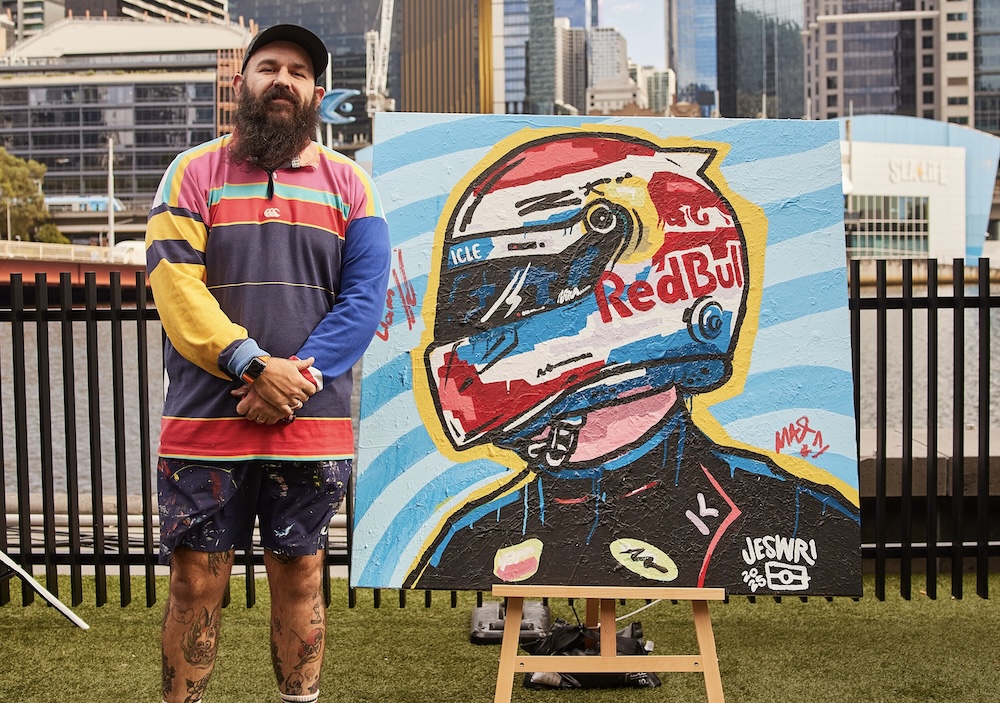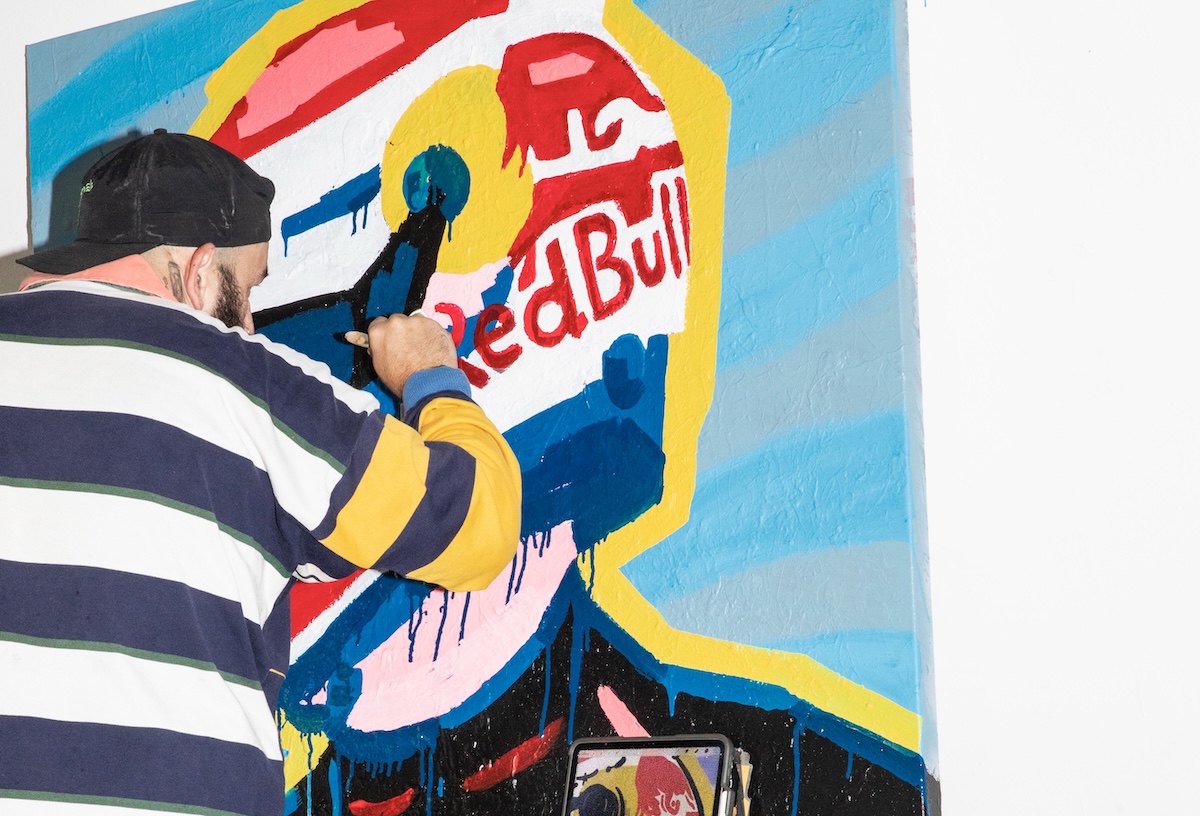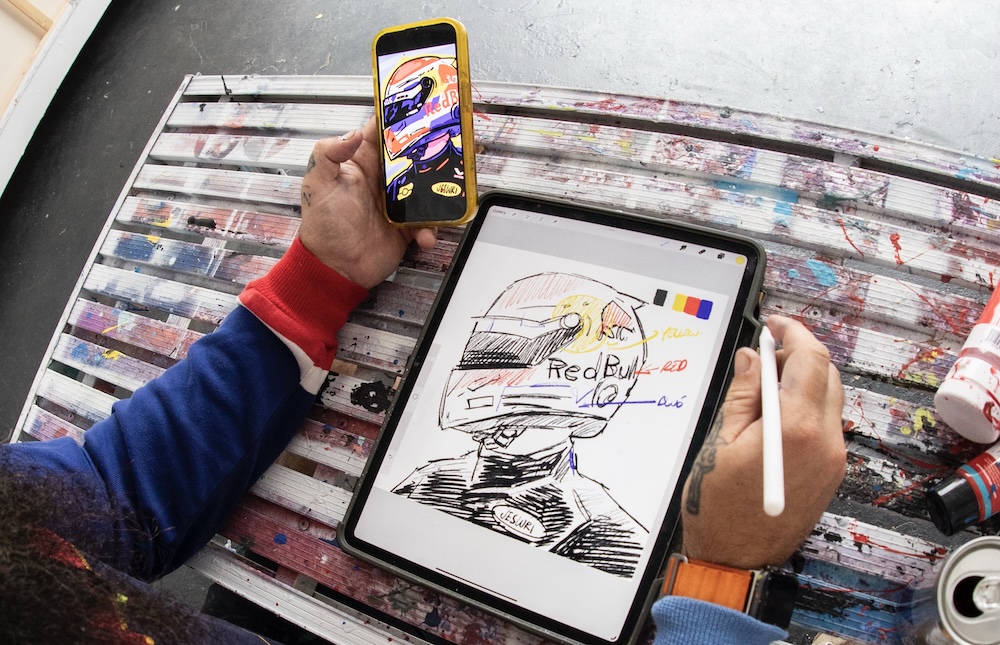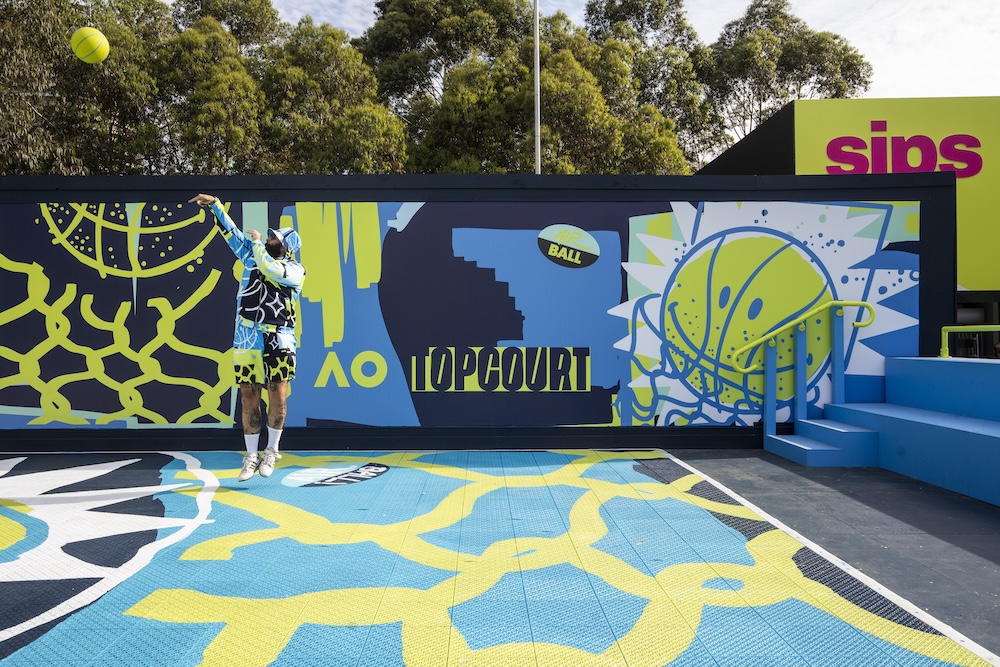Campaign Brief Q&A with Gadigal street artist + former ad creative JESWRI: “I feel like my time in adland only poured petrol in my artistic drive”

Fresh off a collaboration with Red Bull Racing, Gadigal street artist and former ad creative Jesse Wright—aka JESWRI, continues to blur the lines between commercial and cultural storytelling. Represented by First Nations-led illustration agency Solid Lines, currently supported by artist representation agency The Jacky Winter Group, JESWRI recently caught up with Campaign Brief to chat about his latest project with Red Bull, how his time in advertising still influences his work, and balancing artistic identity with big-brand collaborations.
How did you approach the concept for this piece? Were there specific elements of Red Bull Racing or Formula One that inspired you?
I’ve always wanted to work with Red Bull, and actually manifested wanting it to happen this year six weeks prior to hearing from their team. Crazy ay?
It all moved so fast that I was allowed to be very integral in my application to the canvas. My style is rooted in graffiti, so painting under pressure is something I’ve been comfortable with since I was a teenager; which is when I drank the most Red Bull.
I took inspiration from the riders’ helmets, looking at them rapidly over a coupla cans of Red Bull. Fusing them into one and bringing in the Red Bull brand colours.
Your artwork took inspiration from Melbourne’s Laneways—what aspects of the city’s street art culture did you aim to capture?
Being a street artist with a graffiti background, working fast comes natural. I layer my canvases with paint and plaster, and sometimes concrete to give the same feeling of a wall on the street—typical of what you might see in Melbourne’s laneways.
I’m not a ‘traditional’ gallery artist by trade, no textures are ever perfect; so I lean into what makes my clients feel like they’re working with an authentic street artist. For Red Bull, I gave the tones and blocks of colour a feeling like they’ve been rolled on with a roller brush—a style I’ve been painting for the last few years in my portraits. My style is adaptive, but always looks like mine.

How does your Gadigal heritage influence your work, and did it play a role in shaping this particular piece?
Aboriginal people are historically the first artists. My heritage plays a role in my art practice as a whole. I’m only an artist because my mum before me was an artist and art teacher. She allowed me to have artistic freedom and find my own way as an artist. My art style might not fit the conventions of what defines traditional / cultural art or what we call Dreamtime, but it represents the Mob and redefines the expectations of what our art looks like and needs to look like.
Being raised in Inner City, Gadigal, I’ve got a unique story that is being told visually through all my art, commercial or not. Whether it’s application, colour palettes, materials or other things that connect me with my heritage on the process side.
What was it like working with Red Bull on such a big project? Did they give you a brief, or did you have creative freedom?
Big project…You’re right. I manifest these jobs at volume; so I often have to actually pinch myself in these moments and be like holy shit this is a mad opportunity, wake up and smell the roses. A conversation I have with myself all the time.
For the brief, yes and no. It was creative freedom, with client’s input. Bit of the old 50/50. Apart from this piece being a career bucket list item, the real life bucket list is hijacking that little shoebox of a car with the Red Bull can on-top. That’s a dream come true.

Prior to pursuing art full time, you worked in advertising. How did your time in advertising shape your artistic style and approach to commercial work?
I feel like my time in ‘ad-land’ only poured petrol in my artistic drive. I was a graphic designer before going to AWARD School and learning to be an Art Director—something every aspiring art director should do. Working in ads was really fun, I was a freelancer the whole time, some longer stints than others, but I got to bounce around and keep myself really entertained.
I liked it and I still miss working in an agency sometimes, probably why I’ve just put myself into a PhD, to be around creative people again. Being an artist is very similar to being a freelancer, I’m just using a different medium to get my creativity out. I’m driven, it shows. It’s why I did so well as a creative in ad-land and it’s definitely shaped my approach in ways I can’t label as anything other than familiarity.
Ad-land is a familiar landscape, I know how to navigate the terrains and I speak the local language. I felt very welcome during my time with agencies and if I wasn’t painting all the time, you’d definitely see me playing ping-pong during work hours and coming up with the next big youtube pre-roll.
What led to your decision to leave advertising and pursue your art full-time in 2017?
Those ‘beat the buzzer’ YouTube pre-rolls, that was my final straw hahah.
No, honestly—I just felt a calling. I was being offered painting projects that clashed with my time in agencies. I felt like I wanted to paint more than I wanted to sit at a desk and come up with the $10m campaign for two radio hosts which I thought were gronks. It was a promise to myself when I got into graffiti, I always wanted to make money from art. I was a young disillusioned graphic designer who thought going to Billy Blue College of Design would make me the artist I dreamt of, but I realised that the more safety nets I removed in my life, the closer I got to being a career artist. I had no idea what that looked like and to be honest, I’ve achieved all the things I wanted to do as an artist. I’m constantly writing myself new goals. I wanted to achieve more FOR ME, not for anyone else.
Are there any lessons from your days as an art director that you still apply to your work today?
Honestly, all the AWARD School stuff plays into my head every project. How to think well past the expected deliverables to try and have something playful and memorable.
I learnt that I didn’t like creating ‘content,’ but I really enjoyed trying to create conversations, push boundaries and be silly wherever I can.
The mental headspace you create as an art director when you’re concepting, creating, fleshing out, chopping, changing, resetting and seeing a project through to completion is something I experience a lot with what I’m doing. Being an art director gave me thick skin.
I’ve worked on both sides of the fence now, I know how to get shit done. I understand my place on a project because I’ve done the reps but also because I’ve been the one that gave feedback and worked with artists. So, when I’m the artist being celebrated and collaborating with the team, I understand where I need to be and how to get shit done.
You’ve collaborated with a huge range of brands, from Converse and PlayStation to Adobe and Samsung. How do you balance maintaining your own artistic identity while working within a brand’s vision?
I think of the analogy of Bruce Lee; ““Empty your mind. Be formless, shapeless like water. Now you put water into a cup, it becomes the cup. You put water into a bottle, it becomes the bottle. You put water in a teapot, it becomes the teapot. Now water can flow or it can crash. Be water my friend.”
My work isn’t flexible, it’s adaptive, but integrally water is water, it’s not anything else. It’s strong but formless. Commercial work doesn’t mean the death of authenticity, it just means the client you’re collaborating with wants to be in your shoes for a minute and see their project through your lens. How much you give them is up to the artist. You can give them pretty people skipping or you can slap their logo on your art. It’s not as linear as that, but you get the idea.
I think building up an extensive folio has helped strengthen my backbone when it comes to approaching my work stylistically. I found my style by painting for myself, sometimes that meant illegally or without pay, I needed to find what essentially I loved doing. I think it’s something that emerging creatives do when approaching projects is think to themselves ‘what do I think the client wants’ and it doesn’t help if you don’t have a strong sense of style in your folio.
I’ve been painting walls since I was 14 and drawing since I was a child. My art definitely doesn’t look the same as it did then, nobody wants to see that. Clients want to see what their project looks like through my lens at that particular moment in my career, I’m doing something that appeals to them. I’m not the artist that sells you 100 years of copy and paste, I’m a human and my art grows with me.

The projects arrive at particular points in my career, like nodes on a map and they will resemble the works I’m creating at that time. So, when I look back at my career as a whole, the style flows through my work like water.
My lens is so unique to me, the way that I see the world. They could change the channel and work with another artist for their unique lens but at the end of the day, when clients come to me they want to see how I approach it, what it looks like visually and what story I can craft around it with my process and voice.
If you could collaborate with any brand or agency in the future, who would it be and why?
I love some of the places I’ve worked like The Monkeys, R/GA, and JOY, to name a few.
I’d like to work with M&C Saatchi. I’m interested in doing big takeovers, lifting my collaboration game and big public space takeovers.
My dream clients are growing and I’ve worked with a lot of my dream clients already including Converse & Playstation. I’d love to work with Nike, Marvel, and Star Wars. I’m a big nerd at heart. I’d like to feature my art in a movie like Spider-verse or TMNT.
What’s next for you? Are there any upcoming projects or collaborations you’re excited about?
• THE JOURNEY BACK TO AD-LAND
• Entered the Archibald Prize 2025 (fingers crossed)
• Working with Wingstop for a new mural
• Creating an spacial activation for Bethesda (DOOM: Dark Ages)
• Triple J in office mural
• Few more secret projects I’m working on in the background
• CURRENTLY: Undertaking PhD of Art. Topic is ‘decolonising public spaces through the lens of street art, extending first nations narratives’
• OWN: Honey Bones Gallery in Brunswick
Jesse Wright, aka JESWRI (pron. Jess-Rye) is a Gadigal artist of the Eora Nation. Born and raised in Sydney and now living in Naarm, JESWRI is known for his large-scale street art. JESWRI has collaborated with brands such as Converse, Adidas, PlayStation, Vivid Sydney, and most recently, Red Bull. Before devoting his practice to art, JESWRI lived as a graffiti artist, writer, designer, and commercial art director. He also runs and operates one of Melbourne’s most exciting new art galleries, Honey Bones Gallery in Brunswick / Wurundjeri Country.
Red Bull BTS + Australian Open Hoops photography: Jack Gruber
Red Bull event photography: Rasyiddin Faizal
